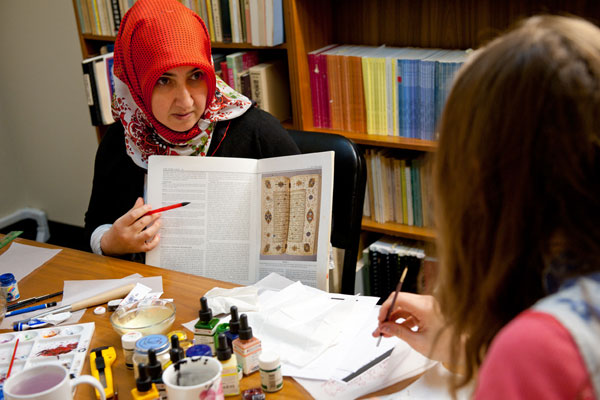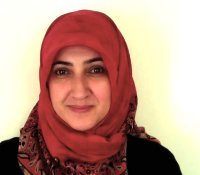
“Hey, Lady!”
On an autumn afternoon of 2004, I was at the bus stop across from Panera Bread on North University Avenue in Ann Arbor. The street was unusually crowded for a small town at that hour of the day.
All of a sudden, I heard someone yell, “Hey, Lady!”
At first, I did not take it personally; as I said, the street was crowded. Yet when he yelled one more time, waving his right hand at me, I noticed that a middle aged, white American man with a cheerful voice was trying to get my attention from the other side of the street:
“Hey! I like your headscarf! It is a beautiful scarf!”
Embarrassed and puzzled, I thanked him from afar. Waving his hand one more time, he walked into the crowd.
That afternoon, I went home with a big smile on my face. I related what had happened to my husband and young daughters, and even called a few Turkish friends to tell about the strange man on the street. I do not know how many people I told this story to on the next day, and the day after, and after and after.
It is very surprising to hear that a woman in her thirties becomes as happy as a little girl who is told that her pink princess dress is very pretty, isn’t it?
No, it is not. Not if this is the first time someone has told her, “I like your headscarf.”
I was thirty-four years old at that time, and had been wearing a headscarf for twenty-four years. All these years, I had been isolated and insulted for my headscarf, even in my home country of Turkey where the secular government had banned their use in schools and state buildings.
I was born in a small conservative village outside of Denizli, a relatively large city in western Turkey. Wearing a headscarf was as usual as climbing big oak trees, or going to the market on my own, as it was a sign of being the young adult woman in my family.
It was not until I was in the fifth grade that I began to learn that wearing a headscarf was not acceptable in the official buildings. Not only did the principal warn me to take it off, but some teachers also expressed their grief for “a poor little girl” who “was forced by her family to cover her hair at such an early age.”
I was only ten, and I had no idea why I was scolded for wrapping a scarf over my hair. Were we not the sole owners of our bodies?
Upon graduating from elementary school, I began a middle school that had an intensive Islamic program. Due to the nature of the school, I thought I would be free to wear my headscarf, but the ban was strictly applied in that school as well. Furthermore, retired generals often interrupted our classes to monitor the eleven-year-old girls and guarantee the long life and safety of Turkish Republic’s fragile laïcité. Within the classrooms, hallways, and gardens, high level military officers with their shiny medallions and knitted brows constantly watched us to ensure that none of us dared to put a piece of fabric on top of our lifeless thin hairs.
Not only these officers, but also our principal and some obsequious teachers wandered within the school to prevent us from wearing headscarves in the building. It was quite common to hear a teacher scream, “Hey! You! Take off your headscarf! It is forbidden! How many more times do we have to tell you this?”
I graduated from high school in 1988, and got married within the next few months. The ban was still very strict, and attending a college while wearing my headscarf seemed impossible.
In 1990, the ban was abolished at colleges, and a few years later, I began college when my older daughter turned three years old. I thoroughly enjoyed the freedom in the first three years of college until the postmodern coup of 1997, when the headscarf was once again banned, and the buildings and campuses were closely monitored by the military.
When I graduated from college, I was allowed to be neither a teacher in a high school nor a graduate student in a university. While some headscarf-wearing female students took off their scarves, many began to wear wigs on top of their scarves as a solution. So did I. We did not take off our headscarves, and these soldiers did see some hair as they wished. It seemed to be a workable solution, but not an easy one. I practiced with my wig, like that curly hair wig online, for about a week at home. I looked at myself in the mirror from the front, back, right, and left… no matter the angle, what I saw in the mirror was not me.
The embarrassment was unbearable.
Then, we discovered another solution. We would hide behind a wall until the moment the soldiers disappeared so that we could sneak into the building with our headscarves, yet without our wigs. On one of those days, in an empty hallway, I was caught and sent to the dean’s office. The dean was waiting for me on his glorious chair. I was able to see anger in his eyes and on his shaking lips. While writing down my advisor’s name to report my “illegal” entrance into the building, he repetitively scolded me, “How many times do we have to tell you girls that the headscarf is forbidden!”
I left the dean’s office holding back my tears until I reached the hallway. That day, through my tears, I swore to God that I would complete my Ph.D. no matter what. And so I did – with a wig on top of my headscarf.
It was after all these disappointments that my husband, who was a professor at the Medical School, and I decided to move to the United States, which promised to be the land of freedom. We left our sweet homes, cold rivers, purple mountains, beloved families, friends, neighbors, little boys who used to sell lemonade at the Saturday bazaar, cheerful flower ladies on the corner of the campus, aged coppersmiths, patient saddle makers, cobblers, and chatty antique dealers in the old bazaars, so that our two daughters would not experience the same pain and humiliation; so that no one would ever blame and scold them for wearing headscarves.
We arrived in August, and in the following month the tragic September 11 attacks happened.
In a month, like many Muslim women in the States, I quickly learned that wearing a headscarf might make me an easy target to those who failed to distinguish between innocent people and terrorists, and to those who did not know the depth of disappointments, fears, concerns, pains, and tears we also carried in our hearts. Many Muslims came to this country for the promise of freedom, leaving behind their loved ones. However, increasing verbal and physical harassment towards them in the media and public has forced some Muslim women to hide their religious identity. Some decided to take off their headscarves, while others began wearing hats on top of them. It is indeed heartbreaking that many of these women who came to the States with hearts full of hopes and dreams are feeling more and more overwhelmed day after day due to simply trying to live by their religious conscience.
To the gentle man who waved his hand at me from the other side of the street in the autumn of 2004, I hope you read this and remember the Muslim woman with the beautiful headscarf. This letter is to tell you that your courtesy has not been forgotten. On that autumn afternoon, you touched a wounded heart that had been bleeding for twenty-four years.
Whoever you are, wherever you are; may God touch your heart too.
 Dr. Ozgen Felek received her first Ph.D. from Firat University in Ottoman & Islamic culture and literature in 2007, and her second Ph.D. in 2010 in the Near Eastern Studies from the University of Michigan with an emphasis on Ottoman dream culture and mysticism.
Dr. Ozgen Felek received her first Ph.D. from Firat University in Ottoman & Islamic culture and literature in 2007, and her second Ph.D. in 2010 in the Near Eastern Studies from the University of Michigan with an emphasis on Ottoman dream culture and mysticism.
She was a Mellon Postdoctoral Fellow in the Department of Religious Studies at Stanford University for two years before moving to New York. She is now a Postdoctoral Research Fellow at the Graduate Center of CUNY in Manhattan, NY. Currently, she is working on a book project titled Imperial Men: Manhood and Masculinity in the Early Modern Ottoman Empire.
Dr. Felek may be reached at ofelek@gc.cuny.edu.
